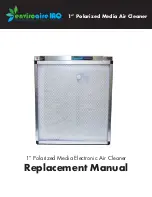
Commercial Air Conditioner
Model: heat pump, 10SEER UNITS
16
The metal parts of the unit may be subject to rust or corrosion in adverse environmental
conditions. This oxidation could shorten the unit life. Salt spray or mist in seacoast areas,
sulphur or chlorine from lawn watering systems and various chemical contaminants from
industries such as paper mills and petroleum refineries are especially corrosive.
If the unit is to be installed in an area where contaminants are likely to be a problem, special
attention should be given to the equipment location and exposure.
Avoid having lawn sprinkler heads spray directly on the unit cabinet.
In coastal areas, locate the unit on the side of the building away from the waterfront.
Shielding provided by fence or shrubs may give some protection.
Regular maintenance will reduce the buildup of contaminants and help to protect the unit's
finish.
! WARNING
- Disconnect all electrical power to the unit before servicing. Disconnect power
to both the indoor and outdoor units. NOTE: There may be more than one electrical
disconnect switch. Failure to shut off power can cause electrical shock resulting in personal
injury or death.
Frequent washing of the cabinet, fan blade and coil with fresh water.
Regular cleaning and waxing of the cabinet with good automobile polish.
A good liquid cleaner may be used several times a year to remove matter that will not wash
off with water.
The best protection is frequent cleaning, maintenance and minimal exposure to
contaminants.
8.3 INSTALLATION
These units are designed for outdoor installations. They can be mounted on a slab or
rooftop. It is important to consult your local code authorities at the time the first installation
is made.
Check following points before attempting any installation:
Structural strength of supporting members.
Clearances and provision for servicing.
Power supply and wiring.
Location for minimum noise, where operating sounds will not disturb owner or neighbors.
Location where there is no risk of combustible gas leakage.
Location where external water drainage cannot collect around the unit.
Location where roof runoff water does not pour directly on the unit. Provide gutter or other
shielding at roof level. Don't locate unit in an area where excessive snow drifting may occur
or accumulate.
Provide a level concrete slab. To prevent transmission of noise or vibration, slab should not
be connected to building structure. Some sort of sound-absorbing material should be placed
between the condenser and the slab. A good material to use is rubber and cork pad.
For rooftop application, make sure the building construction can support the weight and that
proper consideration is given to the weather-tight integrity of the roof. The condensing unit
contains moving parts and can vibrate. Therefore, sound is also a consideration in rooftop
applications.
















































